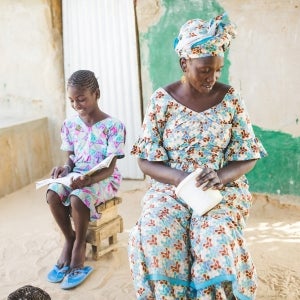Despite significant strides toward gender equality, the financial inclusion of women remains a pressing issue globally, with access to credit remaining a major barrier. Analysis by CGAP and MFR between 2019-2023 of over 300 microfinance institutions (MFIs) used data from the ATLAS database to explore the trends, challenges, and successes in closing the gender credit gap for smaller borrowers and tried to identify optimal designs for institutional structures aimed at supporting more women clients, more equitably, and in more parts of the world. The data suggest a positive correlation between better gender outreach and a range of interrelated factors – institutions that tend to be smaller or are organized as NGOs and those that provide group loans. A more detailed analysis with additional insights can be found in the associated report.
Global trends and regional variations in women’s access to microfinance
Looking first at the high-level picture, the percentage of female borrowers globally stayed relatively stable over the period studied, hovering between 57% and 61% of total customers served by the institutions in the database. However, this higher apparent share masks underlying disparities. For instance, while about half of borrowers are women, they usually receive smaller loans compared to their male counterparts. and their overall share of loans in the portfolio remained below 50% over the period 2019–2023. This suggests a form of financial exclusion even where women are nominally included on equal terms.
It is also worth noting that the distribution of financial services to women varies significantly across regions. South and Southeast Asia lead in gender outreach, with a relatively equal number of female borrowers and loan volumes. Contrastingly, Europe and Central Asia lag, with relatively fewer female borrowers and smaller loan sizes. This variation largely reflects the types of institutions in different parts of the world. The graphic below shows that group and village banking dominate in South and Southeast Asia, while individual lending is more common in Europe and Central Asia.


Group and village lending typically requires less stringent collateral, and as it permits smaller loan sizes may be better suited to the needs of smaller entrepreneurs, thus being more accessible to women who may have limited access to the guarantees or collateral needed to support a loan application. Individual lending models have much lower outreach to women, as shown in the graph below. This highlights the barriers women face with traditional banking practices, especially in raising and pledging collateral.
Two particular structural observations of interest emerged from the analysis, as seen in the graphic below. The first is that smaller financial institutions tend to serve a higher percentage of female borrowers compared to larger ones. Second, non-governmental organizations (NGOs) show some of the best results in gender outreach.


Gender outreach and financial performance
Looking at the financial performance of institutions that prioritize gender outreach, we find a nuanced picture. In particular, the data indicates that institutions with strong gender outreach metrics often report lower Portfolio at Risk (PAR) rates possibly due to female borrowers often seen to be more reliable in repaying loans compared to their male counterparts. This could be due in part to the more cautious financial behavior often observed among women clients, who tend to only borrow within their repayment capacities. However, there are other factors at work in determining the overall sustainability of these institutions. These include:
- Operational expenses: Institutions focused on smaller individual loans to women incur higher operational costs due to the intensive nature of managing the numbers and the higher associated unit costs. These costs can offset the lower credit risk associated with women borrowers. By contrast, group lending reduces costs and spreads risk through shared responsibility, but it can limit individual entrepreneurship and the ability to scale up.
- Funding sources: The diversity and stability of funding sources significantly impact the sustainability of financial institutions. Those who depend heavily on donor funding or subsidized loans may face sustainability challenges if such support diminishes, while institutions that have diversified their funding sources, including taking on deposits, tend to have greater financial resilience.
- Economies of scale: Smaller institutions, which often show better performance in gender outreach, frequently struggle to achieve scale. Their smaller operational scope can lead to higher per-unit costs compared to larger institutions.
So, while institutions with excellent gender outreach often demonstrate good credit performance, their overall financial health depends on managing a wider and complex array of difficult operational and economic challenges. This also leads us to a fundamental policy question that needs to be addressed. Should supporters of women’s financial inclusion focus more of their attention on the smaller, less financially sustainable institutions that demonstrate excellence in gender outreach, and help them improve their operational efficiencies, provide them with longer-term preferential funding, and assist them in scaling up their operations? Or should the primary focus instead be on engaging with larger, financially stronger local financial institutions (such as commercial banks) to try and improve their interest in and ability to serve women customers more equally? This can be a big ask, as the previous graphs show – institutions that provide predominantly individual loans generally have a mountain to climb in terms of equalizing their offering between men and women.
The impact of female board members
If the path of supporting larger institutions is chosen, then there is one important additional finding from this study that could be helpful in improving outcomes, as seen in the graph below.

The study examined the extent to which having more female staff overall, and more female managers specifically, affected an institution’s performance with female customers. These showed minimal impact. However, having women on the boards of directors showed a significantly positive effect. Institutions with more women on their boards tend to give more loans to female clients, and in more equal proportions, suggesting a correlation between female representation at the top and a significant influence on organizational priorities and outcomes in women’s financial inclusion. This could be an important driver of change for larger, more commercial financial service providers.
Conclusion
As the financial inclusion sector strives to reach gender equity, it is clear that a more innovative and multifaceted approach—considering institutional size, type, geographic focus, and above all, the specific needs of women—is essential. As is the exploration of alternative structures that could combine outcome targets with commercial efficiency, agility, and ingenuity in more innovative ways. Incentives to achieve more gender equality could provide a much-needed boost to leveling the playing field for women.



